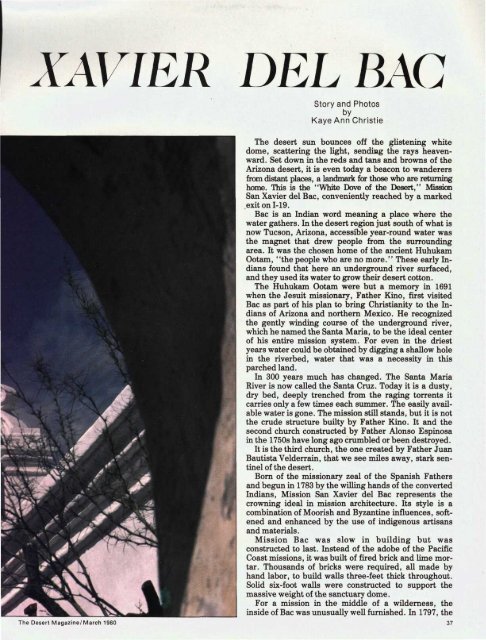BYWAYS PLUS: DATES! - Desert Magazine of the Southwest
BYWAYS PLUS: DATES! - Desert Magazine of the Southwest
BYWAYS PLUS: DATES! - Desert Magazine of the Southwest
Create successful ePaper yourself
Turn your PDF publications into a flip-book with our unique Google optimized e-Paper software.
XAVIER DEL BAG<br />
Story and Photos<br />
by<br />
Kaye Ann Christie<br />
The <strong>Desert</strong> <strong>Magazine</strong>/March 1980<br />
The desert sun bounces <strong>of</strong>f <strong>the</strong> glistening white<br />
dome, scattering <strong>the</strong> light, sending <strong>the</strong> rays heavenward.<br />
Set down in <strong>the</strong> reds and tans and browns <strong>of</strong> <strong>the</strong><br />
Arizona desert, it is even today a beacon to wanderers<br />
from distant places, a landmark for those who are returning<br />
home. This is <strong>the</strong> "White Dove <strong>of</strong> <strong>the</strong> <strong>Desert</strong>," Mission<br />
San Xavier del Bac, conveniently reached by a marked<br />
exit on 1-19.<br />
Bac is an Indian word meaning a place where <strong>the</strong><br />
water ga<strong>the</strong>rs. In <strong>the</strong> desert region just south <strong>of</strong> what is<br />
now Tucson, Arizona, accessible year-round water was<br />
<strong>the</strong> magnet that drew people from <strong>the</strong> surrounding<br />
area. It was <strong>the</strong> chosen home <strong>of</strong> <strong>the</strong> ancient Huhukam<br />
Ootam, "<strong>the</strong> people who are no more." These early Indians<br />
found that here an underground river surfaced,<br />
and <strong>the</strong>y used its water to grow <strong>the</strong>ir desert cotton.<br />
The Huhukam Ootam were but a memory in 1691<br />
when <strong>the</strong> Jesuit missionary, Fa<strong>the</strong>r Kino, first visited<br />
Bac as part <strong>of</strong> his plan to bring Christianity to <strong>the</strong> Indians<br />
<strong>of</strong> Arizona and nor<strong>the</strong>rn Mexico. He recognized<br />
<strong>the</strong> gently winding course <strong>of</strong> <strong>the</strong> underground river,<br />
which he named <strong>the</strong> Santa Maria, to be <strong>the</strong> ideal center<br />
<strong>of</strong> his entire mission system. For even in <strong>the</strong> driest<br />
years water could be obtained by digging a shallow hole<br />
in <strong>the</strong> riverbed, water that was a necessity in this<br />
parched land.<br />
In 300 years much has changed. The Santa Maria<br />
River is now called <strong>the</strong> Santa Cruz. Today it is a dusty,<br />
dry bed, deeply trenched from <strong>the</strong> raging torrents it<br />
carries only a few times each summer. The easily available<br />
water is gone. The mission still stands, but it is not<br />
<strong>the</strong> crude structure builty by Fa<strong>the</strong>r Kino. It and <strong>the</strong><br />
second church constructed by Fa<strong>the</strong>r Alonso Espinosa<br />
in <strong>the</strong> 1750s have long ago crumbled or been destroyed.<br />
It is <strong>the</strong> third church, <strong>the</strong> one created by Fa<strong>the</strong>r Juan<br />
Bautista Velderrain, that we see miles away, stark sentinel<br />
<strong>of</strong> <strong>the</strong> desert.<br />
Born <strong>of</strong> <strong>the</strong> missionary zeal <strong>of</strong> <strong>the</strong> Spanish Fa<strong>the</strong>rs<br />
and begun in 1783 by <strong>the</strong> willing hands <strong>of</strong> <strong>the</strong> converted<br />
Indians, Mission San Xavier del Bac represents <strong>the</strong><br />
crowning ideal in mission architecture. Its style is a<br />
combination <strong>of</strong> Moorish and Byzantine influences, s<strong>of</strong>tened<br />
and enhanced by <strong>the</strong> use <strong>of</strong> indigenous artisans<br />
and materials.<br />
Mission Bac was slow in building but was<br />
constructed to last. Instead <strong>of</strong> <strong>the</strong> adobe <strong>of</strong> <strong>the</strong> Pacific<br />
Coast missions, it was built <strong>of</strong> fired brick and lime mortar.<br />
Thousands <strong>of</strong> bricks were required, all made by<br />
hand labor, to build walls three-feet thick throughout.<br />
Solid six-foot walls were constructed to support <strong>the</strong><br />
massive weight <strong>of</strong> <strong>the</strong> sanctuary dome.<br />
For a mission in <strong>the</strong> middle <strong>of</strong> a wilderness, <strong>the</strong><br />
inside <strong>of</strong> Bac was unusually well furnished. In 1797, <strong>the</strong><br />
37
















